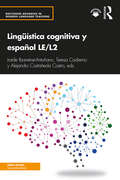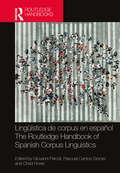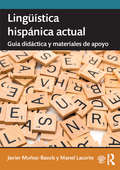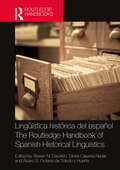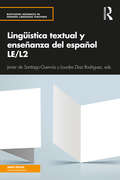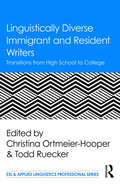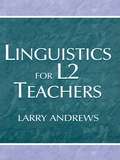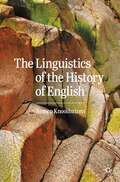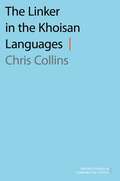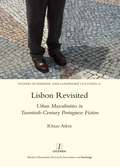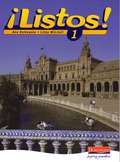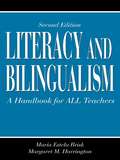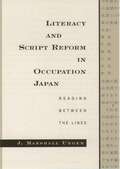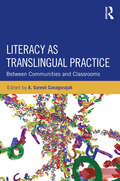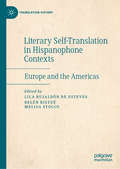- Table View
- List View
Lingüística cognitiva y español LE/L2 (Routledge Advances in Spanish Language Teaching)
by Iraide Ibarretxe-Antuñano Teresa Cadierno Alejandro Castañeda CastroLingüística cognitiva y español LE/L2 constituye una valiosa aportación al estudio de la adquisición y la enseñanza del español LE/L2 desde la perspectiva teórica de la lingüística cognitiva. Se trata de la primera obra escrita en español en la que se ofrece una introducción a la lingüística cognitiva y su aplicación didáctica a la enseñanza del español LE/L2 desde una óptica internacional. Combina una orientación teórico-práctica que incluye diferentes estudios empíricos con pautas para ayudar a los profesores de español a integrar la lingüística cognitiva en la enseñanza de la lengua. Características principales: Una estructura homogénea y facilitadora de la lectura de los distintos capítulos que sirve para integrar contenidos lingüísticos y gramaticales desde un punto de vista cognitivo; Cuestiones clave en la enseñanza del español LE/L2 desde la óptica de la lingüística cognitiva: aspectos controvertidos de gramática, el desarrollo de la competencia metafórica, el aprendizaje del léxico, la influencia de la lengua materna, el foco en la forma, el uso de la traducción pedagógica; Pautas y sugerencias para aplicar la lingüística cognitiva en la enseñanza de la lengua, así como futuras vías de investigación; Una selección de imágenes, gráficos e ilustraciones para facilitar la comprensión de los temas y conceptos que se abordan en el volumen; Un glosario bilingüe (español e inglés) de términos clave para que cualquier lector pueda familiarizarse con los conceptos fundamentales de la lingüística cognitiva. Escrito en español, de manera clara y accesible, y con abundantes ejemplos, Lingüística cognitiva y español LE/L2 es una obra de referencia para docentes de español como LE/L2, estudiantes graduados y formadores de profesores, así como para cualquier persona que desee adquirir una perspectiva actual sobre las principales aportaciones teóricas y prácticas de la lingüística cognitiva a la enseñanza y el aprendizaje de segundas lenguas.
Lingüística de corpus en español / The Routledge Handbook of Spanish Corpus Linguistics (Routledge Spanish Language Handbooks)
by Giovanni Parodi Pascual Cantos-Gómez Chad HoweLingüística de corpus en español/The Routledge Handbook of Spanish Corpus Linguistics muestra el modo en que ha cambiado el panorama de la denominada lingüística de corpus en español y cómo en la actualidad ha llegado a concitar un espacio disciplinar independiente, y, al mismo tiempo, integrar estos conocimientos en cualquier programa de estudios, investigación o diseño curricular en educación superior. Este volumen lo componen 36 capítulos que ofrecen un panorama amplio, diverso y comprehensivo de los avances en lingüística de corpus de y en español, abarcando un vasto repertorio de conceptos esenciales y de aspectos teóricos y metodológicos desde una conceptualización de la lingüística contemporánea tanto inter como transdisciplinaria. Los ámbitos que se cubren no son ni estancos, ni definitivos, ni, mucho menos, los únicos. Son perfectamente susceptibles de revisión, de mejora y/o de cambio. El objetivo último de esta obra no es el limitar o fijar, sino todo lo contrario, es el de motivar y provocar a los lectores y lectoras para que no cesen las avenidas de propuestas innovadoras en el ámbito de la lingüística de corpus del español y seguir así profundizando en el conocimiento de esta lengua. Lingüística de corpus en español / The Routledge Handbook of Spanish Corpus Linguistics shows how the landscape of corpus linguistics in Spanish has changed and how it has become an independent discipline while incorporating this knowledge into any syllabus, research or curriculum design in higher education. This volume comprises 36 chapters that provide a broad, diverse and comprehensive overview of advances in corpus linguistics of and in Spanish, covering a vast repertoire of essential concepts as well as theoretical and methodological aspects from a conceptualization of contemporary linguistics that is both inter- and transdisciplinary. The fields covered are not definitive, or even the only ones. They are entirely open to revision, improvement and/or change. The goal of this work is not to fix or limit these topics. On the contrary, it is intended to motivate and provoke the readers to continue exploring new avenues of innovative proposals in the field of Spanish corpus linguistics and thus deepen their knowledge of this language.
Lingüística de corpus en español / The Routledge Handbook of Spanish Corpus Linguistics (Routledge Spanish Language Handbooks)
by Giovanni Parodi Pascual Cantos-Gómez Chad Howe Manel Lacorte Javier Muñoz-BasolsLingüística de corpus en español/The Routledge Handbook of Spanish Corpus Linguistics muestra el modo en que ha cambiado el panorama de la denominada lingüística de corpus en español y cómo en la actualidad ha llegado a concitar un espacio disciplinar independiente, y, al mismo tiempo, integrar estos conocimientos en cualquier programa de estudios, investigación o diseño curricular en educación superior. Este volumen lo componen 36 capítulos que ofrecen un panorama amplio, diverso y comprehensivo de los avances en lingüística de corpus de y en español, abarcando un vasto repertorio de conceptos esenciales y de aspectos teóricos y metodológicos desde una conceptualización de la lingüística contemporánea tanto inter como transdisciplinaria. Los ámbitos que se cubren no son ni estancos, ni definitivos, ni, mucho menos, los únicos. Son perfectamente susceptibles de revisión, de mejora y/o de cambio. El objetivo último de esta obra no es el limitar o fijar, sino todo lo contrario, es el de motivar y provocar a los lectores y lectoras para que no cesen las avenidas de propuestas innovadoras en el ámbito de la lingüística de corpus del español y seguir así profundizando en el conocimiento de esta lengua. Lingüística de corpus en español / The Routledge Handbook of Spanish Corpus Linguistics shows how the landscape of corpus linguistics in Spanish has changed and how it has become an independent discipline while incorporating this knowledge into any syllabus, research or curriculum design in higher education. This volume comprises 36 chapters that provide a broad, diverse and comprehensive overview of advances in corpus linguistics of and in Spanish, covering a vast repertoire of essential concepts as well as theoretical and methodological aspects from a conceptualization of contemporary linguistics that is both inter- and transdisciplinary. The fields covered are not definitive, or even the only ones. They are entirely open to revision, improvement and/or change. The goal of this work is not to fix or limit these topics. On the contrary, it is intended to motivate and provoke the readers to continue exploring new avenues of innovative proposals in the field of Spanish corpus linguistics and thus deepen their knowledge of this language.
Lingüística hispánica actual: guía didáctica y materiales de apoyo
by Javier Munoz-Basols Manel LacorteLingüística hispánica actual provides step-by-step instructions on how to plan, design, and teach introductory Hispanic Linguistics courses. It is a versatile resource, which can be used in conjunction with Introducción a la lingüística hispánica actual: teoría y práctica. It contains an answer key for all the activities in the main textbook. It also includes additional activities, with clear and accessible explanations for students and instructors, and can accompany other existing texts and courses on Hispanic Linguistics. Features include: • A comprehensive selection of materials which gradually introduce students to the main areas of Hispanic Linguistics: General Linguistics, Phonology and Phonetics, Morphology, Syntax, Semantics and Pragmatics, History of the Spanish Language, Language Variation, and Second Language Acquisition and Language Teaching. • A wide range of carefully-crafted classroom and homework activities, essay questions and research projects to engage students and enrich their learning of Hispanic Linguistics. • Detailed guidance on how to successfully implement each activity in the classroom, suggestions for how to expand and adapt activities for different needs, and a full annotated answer key for instructors to save time planning and implementing lessons. • An extensive bilingual glossary of terms for each of the disciplines covered in the guide helps teachers introduce key concepts and terms in the classroom. Lingüística hispánica actual provides a wealth of activities specially designed to make learning Hispanic Linguistics more dynamic and enjoyable for students.
Lingüística hispánica actual: guía didáctica y materiales de apoyo
by Javier Munoz-Basols Manel LacorteLingüística hispánica actual provides step-by-step instructions on how to plan, design, and teach introductory Hispanic Linguistics courses. It is a versatile resource, which can be used in conjunction with Introducción a la lingüística hispánica actual: teoría y práctica. It contains an answer key for all the activities in the main textbook. It also includes additional activities, with clear and accessible explanations for students and instructors, and can accompany other existing texts and courses on Hispanic Linguistics. Features include: • A comprehensive selection of materials which gradually introduce students to the main areas of Hispanic Linguistics: General Linguistics, Phonology and Phonetics, Morphology, Syntax, Semantics and Pragmatics, History of the Spanish Language, Language Variation, and Second Language Acquisition and Language Teaching. • A wide range of carefully-crafted classroom and homework activities, essay questions and research projects to engage students and enrich their learning of Hispanic Linguistics. • Detailed guidance on how to successfully implement each activity in the classroom, suggestions for how to expand and adapt activities for different needs, and a full annotated answer key for instructors to save time planning and implementing lessons. • An extensive bilingual glossary of terms for each of the disciplines covered in the guide helps teachers introduce key concepts and terms in the classroom. Lingüística hispánica actual provides a wealth of activities specially designed to make learning Hispanic Linguistics more dynamic and enjoyable for students.
Lingüística histórica del español / The Routledge Handbook of Spanish Historical Linguistics (Routledge Spanish Language Handbooks)
by Steven N. Dworkin Gloria Clavería Nadal Álvaro S. Octavio de Toledo y HuertaLingüística histórica del español/The Routledge Handbook of Spanish Historical Linguistics ofrece una síntesis actualizada de los diversos campos que componen la lingüística histórica del español. Este volumen, pionero en su género, estudia la historia interna y externa de la lengua española con atención a los desarrollos teóricos y conocimientos contemporáneos sobre la naturaleza del cambio lingüístico y sobre el papel de los factores no lingüísticos en tales procesos. El volumen, escrito íntegramente en español, reúne contribuciones de un nutrido grupo de expertos internacionales. Con capítulos tanto de destacados filólogos como de lingüistas de orientación más teórica, el volumen ofrece a los lectores una panorámica equilibrada y completa del objeto de estudio desde muy diversas perspectivas de investigación. Esta obra aspira a servir de referencia en el campo de la lingüística histórica española y resultará de interés para estudiosos y profesores interesados en dicho ámbito, así como para los estudiantes de lingüística hispánica. Lingüística histórica del español / The Routledge Handbook of Spanish Historical Linguistics provides a state-of-the-art synthesis of the various fields that comprise Spanish historical linguistics. The first of its kind, the volume studies the internal and external history of the Spanish language within the framework of contemporary developments and insights into the nature of language change and into the role of non-linguistic factors in these processes. Written in Spanish, the volume brings together an international group of expert contributors. With chapters from both eminent philologists as well as more theoretically- oriented linguists, the volume provides readers with a well-balanced and comprehensive overview of the field from many different research perspectives. The volume will be an essential reference on Spanish historical linguistics and will be of interest to scholars and teachers in the field of Spanish historical linguistics, as well as students in Spanish linguistics.
Lingüística histórica del español / The Routledge Handbook of Spanish Historical Linguistics (Routledge Spanish Language Handbooks)
by Steven N. Dworkin Gloria Clavería Nadal Álvaro S. Octavio De Toledo Y HuertaLingüística histórica del español/The Routledge Handbook of Spanish Historical Linguistics ofrece una síntesis actualizada de los diversos campos que componen la lingüística histórica del español. Este volumen, pionero en su género, estudia la historia interna y externa de la lengua española con atención a los desarrollos teóricos y conocimientos contemporáneos sobre la naturaleza del cambio lingüístico y sobre el papel de los factores no lingüísticos en tales procesos. El volumen, escrito íntegramente en español, reúne contribuciones de un nutrido grupo de expertos internacionales. Con capítulos tanto de destacados filólogos como de lingüistas de orientación más teórica, el volumen ofrece a los lectores una panorámica equilibrada y completa del objeto de estudio desde muy diversas perspectivas de investigación. Esta obra aspira a servir de referencia en el campo de la lingüística histórica española y resultará de interés para estudiosos y profesores interesados en dicho ámbito, así como para los estudiantes de lingüística hispánica. Lingüística histórica del español / The Routledge Handbook of Spanish Historical Linguistics provides a state-of-the-art synthesis of the various fields that comprise Spanish historical linguistics. The first of its kind, the volume studies the internal and external history of the Spanish language within the framework of contemporary developments and insights into the nature of language change and into the role of non-linguistic factors in these processes. Written in Spanish, the volume brings together an international group of expert contributors. With chapters from both eminent philologists as well as more theoretically- oriented linguists, the volume provides readers with a well-balanced and comprehensive overview of the field from many different research perspectives. The volume will be an essential reference on Spanish historical linguistics and will be of interest to scholars and teachers in the field of Spanish historical linguistics, as well as students in Spanish linguistics.
Lingüística textual y enseñanza del español LE/L2 (Routledge Advances in Spanish Language Teaching)
by Javier de Santiago-Guervós; Lourdes Díaz Rodríguez; Javier Muñoz-BasolsLingüística textual y enseñanza del español LE/L2 ofrece una visión de conjunto teórico-práctica y actualizada de la Lingüística textual aplicada a la enseñanza del español como lengua extranjera y/o segunda, destinada especialmente a estudiantes graduados y a profesores en formación nativos y no nativos. El volumen, escrito por un elenco internacional de profesores-investigadores, presenta una visión actualizada y práctica de los géneros textuales más frecuentes en programaciones universitarias. Enmarcado por una síntesis actualizada de estudios e investigaciones en lingüística aplicada que recorre distintas perspectivas teóricas y metodológicas, recoge datos y propuestas procedentes de aulas de aprendizaje de español de distintos contextos internacionales. Su principal propósito es suscitar la reflexión teórico-práctica sobre los géneros discursivos y su papel en el aula, y ofrecer una descripción pormenorizada de los mismos para proporcionar al profesorado en formación, nativo y no nativo, recursos prácticos y propuestas didácticas que ejemplifican y guían de manera razonada cómo llevar al aula los distintos géneros textuales. Características principales: • Amplitud de aspectos de la lingüística textual y géneros discursivos abordados enteramente para el español LE/L2 y en español. • Estructuración homogénea de los capítulos que facilita la lectura y da coherencia al conjunto. Atención a géneros escritos y orales desde una perspectiva teórico-práctica que puede inspirar nuevas investigaciones. Atención a la diversidad geolectal del español, a los contextos en que este es L2 (Europa, EEUU) y a la de sus aprendices (hablantes de herencia, L2, LE). Orientado a la aplicación práctica y docente en la clase de L2/LE, cada capítulo dedicado a un género incluye consejos, pautas o actividades para el aula. Incluye temática actual en lingüística textual y aprendizaje de lenguas: escritura académica, divulgación científica, textos jurídicos, aprendizaje mediado por ordenador o el lenguaje de las redes. Capítulos bien fundamentados teórica y bibliográficamente, con sólido respaldo de datos empíricos procedentes de corpus, bien contextualizados. Aborda los aspectos teóricos tradicionales relativos al estudio de la tipología textual y los desafíos metodológicos que afronta el profesor al llevar al aula los distintos géneros discursivos. La presente obra presenta, en un solo volumen, una visión actualizada y práctica de los tipos textuales y géneros discursivos de uso más frecuente desde una perspectiva teórico-práctica: presentación, descripción y puesta en práctica es un esquema de trabajo directo y enormemente útil para su aplicación en el aula. El ámbito internacional en el que se mueven los autores le da una amplitud nunca antes recogida en una obra de lingüística textual. Todo ello hace de Lingüística textual y enseñanza del español LE/L2 una obra de consulta obligada para docentes de español como LE/L2, para estudiantes graduados y formadores de profesores, así como para cualquier persona que desee adquirir una perspectiva actual sobre lingüística textual, géneros discursivos y enseñanza e investigación en español nativo y no nativo.
Lingüística textual y enseñanza del español LE/L2 (Routledge Advances in Spanish Language Teaching)
by Javier De Santiago-Guervós Lourdes Díaz RodriguezLingüística textual y enseñanza del español LE/L2 ofrece una visión de conjunto teórico-práctica y actualizada de la Lingüística textual aplicada a la enseñanza del español como lengua extranjera y/o segunda, destinada especialmente a estudiantes graduados y a profesores en formación nativos y no nativos. El volumen, escrito por un elenco internacional de profesores-investigadores, presenta una visión actualizada y práctica de los géneros textuales más frecuentes en programaciones universitarias. Enmarcado por una síntesis actualizada de estudios e investigaciones en lingüística aplicada que recorre distintas perspectivas teóricas y metodológicas, recoge datos y propuestas procedentes de aulas de aprendizaje de español de distintos contextos internacionales. Su principal propósito es suscitar la reflexión teórico-práctica sobre los géneros discursivos y su papel en el aula, y ofrecer una descripción pormenorizada de los mismos para proporcionar al profesorado en formación, nativo y no nativo, recursos prácticos y propuestas didácticas que ejemplifican y guían de manera razonada cómo llevar al aula los distintos géneros textuales. Características principales: • Amplitud de aspectos de la lingüística textual y géneros discursivos abordados enteramente para el español LE/L2 y en español. • Estructuración homogénea de los capítulos que facilita la lectura y da coherencia al conjunto. Atención a géneros escritos y orales desde una perspectiva teórico-práctica que puede inspirar nuevas investigaciones. Atención a la diversidad geolectal del español, a los contextos en que este es L2 (Europa, EEUU) y a la de sus aprendices (hablantes de herencia, L2, LE). Orientado a la aplicación práctica y docente en la clase de L2/LE, cada capítulo dedicado a un género incluye consejos, pautas o actividades para el aula. Incluye temática actual en lingüística textual y aprendizaje de lenguas: escritura académica, divulgación científica, textos jurídicos, aprendizaje mediado por ordenador o el lenguaje de las redes. Capítulos bien fundamentados teórica y bibliográficamente, con sólido respaldo de datos empíricos procedentes de corpus, bien contextualizados. Aborda los aspectos teóricos tradicionales relativos al estudio de la tipología textual y los desafíos metodológicos que afronta el profesor al llevar al aula los distintos géneros discursivos. La presente obra presenta, en un solo volumen, una visión actualizada y práctica de los tipos textuales y géneros discursivos de uso más frecuente desde una perspectiva teórico-práctica: presentación, descripción y puesta en práctica es un esquema de trabajo directo y enormemente útil para su aplicación en el aula. El ámbito internacional en el que se mueven los autores le da una amplitud nunca antes recogida en una obra de lingüística textual. Todo ello hace de Lingüística textual y enseñanza del español LE/L2 una obra de consulta obligada para docentes de español como LE/L2, para estudiantes graduados y formadores de profesores, así como para cualquier persona que desee adquirir una perspectiva actual sobre lingüística textual, géneros discursivos y enseñanza e investigación en español nativo y no nativo.
Linguistically Diverse Immigrant and Resident Writers: Transitions from High School to College (ESL & Applied Linguistics Professional Series)
by Todd Ruecker Christina Ortmeier-HooperSpotlighting the challenges and realities faced by linguistically diverse immigrant and resident students in U.S. secondary schools and in their transitions from high school to community colleges and universities, this book looks at programs, interventions, and other factors that help or hinder them as they make this move. Chapters from teachers and scholars working in a variety of contexts build rich understandings of how high school literacy contexts, policies such as the proposed DREAM Act and the Common Core State Standards, bridge programs like Upward Bound, and curricula redesign in first-year college composition courses designed to recognize increasing linguistic diversity of student populations, affect the success of this growing population of students as they move from high school into higher education.
Linguistically Diverse Immigrant and Resident Writers: Transitions from High School to College (ESL & Applied Linguistics Professional Series)
by Todd Ruecker Christina Ortmeier-HooperSpotlighting the challenges and realities faced by linguistically diverse immigrant and resident students in U.S. secondary schools and in their transitions from high school to community colleges and universities, this book looks at programs, interventions, and other factors that help or hinder them as they make this move. Chapters from teachers and scholars working in a variety of contexts build rich understandings of how high school literacy contexts, policies such as the proposed DREAM Act and the Common Core State Standards, bridge programs like Upward Bound, and curricula redesign in first-year college composition courses designed to recognize increasing linguistic diversity of student populations, affect the success of this growing population of students as they move from high school into higher education.
Linguistics for L2 Teachers
by Larry AndrewsLinguistics for L2 Teachers is designed to help bilingual and ESL teachers better understand how and why the English language works, and to broaden their abilities to help their students learn about the various functions of English in the real world. It is not a complete curriculum in English linguistics, but rather, a foundation from which teachers can continue to grow and to teach with greater confidence. The reader-friendly, conversational style makes the concepts easily accessible to preservice and in-service teachers who have little or no previous experience in language study. This textbook: * explains various aspects of English using non-technical terminology; * goes beyond the study of grammar to examine the functions of language, not just its form; * presents language applications in L2 classrooms; and * clearly delineates the significance of chapter topics for L2 teachers and students. Each chapter includes prereading activities to enhance the reader's comprehension; postreading activities to expand and elaborate the concepts; and interactive "Be A Linguist" activities to help readers think in ways similar to the ways linguists think and to provide opportunities to apply ideas explained within the chapter. Intended for all teachers of students for whom English is a new language, this text will help them be better prepared to meet the important challenges and questions they encounter in their classrooms.
Linguistics for L2 Teachers
by Larry AndrewsLinguistics for L2 Teachers is designed to help bilingual and ESL teachers better understand how and why the English language works, and to broaden their abilities to help their students learn about the various functions of English in the real world. It is not a complete curriculum in English linguistics, but rather, a foundation from which teachers can continue to grow and to teach with greater confidence. The reader-friendly, conversational style makes the concepts easily accessible to preservice and in-service teachers who have little or no previous experience in language study. This textbook: * explains various aspects of English using non-technical terminology; * goes beyond the study of grammar to examine the functions of language, not just its form; * presents language applications in L2 classrooms; and * clearly delineates the significance of chapter topics for L2 teachers and students. Each chapter includes prereading activities to enhance the reader's comprehension; postreading activities to expand and elaborate the concepts; and interactive "Be A Linguist" activities to help readers think in ways similar to the ways linguists think and to provide opportunities to apply ideas explained within the chapter. Intended for all teachers of students for whom English is a new language, this text will help them be better prepared to meet the important challenges and questions they encounter in their classrooms.
The Linguistics of the History of English
by Remco KnooihuizenThis textbook approaches the history of English from a theoretical perspective. The book provides a brief chronological overview describing the way in which the English language has changed over time from Old English to Modern English, while subsequent parts adopt a theoretical focus that is thematically organised to deal with the question of how and why English changed in the way it did, including a part addressing some specific contact-induced changes and key topics such as English as a Lingua Franca. Supported throughout with information boxes with empirical studies, the examples given are all drawn from English, but boxes with examples from other languages tie the development of the English language into changes in other contexts and settings. This book is an ideal resource for undergraduate students of the English Language and historical linguistics.
LINKER IN KHOISAN LANGUAGES OSCS C (Oxford Studies in Comparative Syntax)
by Chris CollinsThe linker introduces ("links") a variety of expressions into the verb phrase, including locatives, the second object of a double object construction, the second object of a causative, instruments, subject matter arguments, and adverbs. This volume collects together Chris Collins's published work on the linker in the Khoisan languages. Here, Collins offers a systematic description of the linker in [lHoã, Ju|'hoan, N|uu, and to a lesser extent !Xoõ and |Xam. For each language, Collins illustrates various uses of the linker, drawing attention to cross-linguistic generalizations as well as to variation between the languages. The work presented in this volume should be of interest to researchers working in a wide variety of syntactic frameworks on different languages of the world.
The Linker in the Khoisan Languages (Oxford Studies in Comparative Syntax)
by Chris CollinsThe linker introduces ("links") a variety of expressions into the verb phrase, including locatives, the second object of a double object construction, the second object of a causative, instruments, subject matter arguments, and adverbs. This volume collects together Chris Collins's published work on the linker in the Khoisan languages. Here, Collins offers a systematic description of the linker in [lHoã, Ju|'hoan, N|uu, and to a lesser extent !Xoõ and |Xam. For each language, Collins illustrates various uses of the linker, drawing attention to cross-linguistic generalizations as well as to variation between the languages. The work presented in this volume should be of interest to researchers working in a wide variety of syntactic frameworks on different languages of the world.
Lisbon Revisited: Urban Masculinities in Twentieth-Century Portuguese Fiction
by Rhian AtkinTwentieth-century Portugal saw dramatic political and social change. The monarchy was abolished, and a republic installed (1910), soon giving way to a long-lasting dictatorship (1926); a transition to democracy (1974) led to membership of the European Union (1986). But what do we know of how people lived during these periods? And how did men, in particular, respond to the changes taking place in society? In this illuminating and broad-ranging study, Rhian Atkin uses as case studies the work of Fernando Pessoa (1888-1935), Luis de Sttau Monteiro (1926-93) and Jose Saramago (1922-2010) in order to examine the relationship between socio-political change and the construction and performance of masculinities in the urban environment of Lisbon over the course of the last century.
Lisbon Revisited: Urban Masculinities in Twentieth-Century Portuguese Fiction
by Rhian AtkinTwentieth-century Portugal saw dramatic political and social change. The monarchy was abolished, and a republic installed (1910), soon giving way to a long-lasting dictatorship (1926); a transition to democracy (1974) led to membership of the European Union (1986). But what do we know of how people lived during these periods? And how did men, in particular, respond to the changes taking place in society? In this illuminating and broad-ranging study, Rhian Atkin uses as case studies the work of Fernando Pessoa (1888-1935), Luis de Sttau Monteiro (1926-93) and Jose Saramago (1922-2010) in order to examine the relationship between socio-political change and the construction and performance of masculinities in the urban environment of Lisbon over the course of the last century.
Listos! 1 Pupil Book
by Kolkowska Ana Mara Mitchell LibbyThis text provides an introduction to Spanish for pupils in Years 7 and 8, using two-page units with grammar explanations, end-of-chapter checklists and revision tests.
Literacy and Bilingualism: A Handbook for ALL Teachers
by Maria Estela Brisk Margaret M. HarringtonThis handbook applies proven techniques, derived from bilingual/bicultural classrooms, to teaching literacy in the twenty-first century. Its goal is to help teachers increase their understanding of bilingual learners in order to maximize instruction. Teachers can use this handbook to expand their understanding of literacy and bilingualism; implement literacy approaches and assess students’ development; and learn through reflection. Practical, flexible format and content. Complete and straightforward instructions, illustrated by case studies, allow teachers to use the strategies in this handbook on their own or in teacher-led study groups. They can select from the variety of approaches the ones which best match their students’ needs and their own teaching style. Student-centered focus. All of the approaches share characteristics that help motivate students of varying language abilities to develop literacy. Field-tested approaches. The approaches have been modified and tested with bilingual students of different ages and language backgrounds in bilingual, ESL, mainstream, special education, and deaf education classes ranging from preschool through high school. New in the Second Edition: *five new approaches with their corresponding classroom implementation;*additional information in each introduction addressing its theme;*new material on issues of language, culture, and literacy development of students completely new to the English language; and*annotated bibliographies with sample books to support literacy within language and content area classes. Literacy and Bilingualism is intended for a broad audience of teachers in any type of classroom where bilingualism plays a role, and is an excellent text for preservice and inservice courses that prepare teachers to work with English language learners.
Literacy and Bilingualism: A Handbook for ALL Teachers
by Maria Estela Brisk Margaret M. HarringtonThis handbook applies proven techniques, derived from bilingual/bicultural classrooms, to teaching literacy in the twenty-first century. Its goal is to help teachers increase their understanding of bilingual learners in order to maximize instruction. Teachers can use this handbook to expand their understanding of literacy and bilingualism; implement literacy approaches and assess students’ development; and learn through reflection. Practical, flexible format and content. Complete and straightforward instructions, illustrated by case studies, allow teachers to use the strategies in this handbook on their own or in teacher-led study groups. They can select from the variety of approaches the ones which best match their students’ needs and their own teaching style. Student-centered focus. All of the approaches share characteristics that help motivate students of varying language abilities to develop literacy. Field-tested approaches. The approaches have been modified and tested with bilingual students of different ages and language backgrounds in bilingual, ESL, mainstream, special education, and deaf education classes ranging from preschool through high school. New in the Second Edition: *five new approaches with their corresponding classroom implementation;*additional information in each introduction addressing its theme;*new material on issues of language, culture, and literacy development of students completely new to the English language; and*annotated bibliographies with sample books to support literacy within language and content area classes. Literacy and Bilingualism is intended for a broad audience of teachers in any type of classroom where bilingualism plays a role, and is an excellent text for preservice and inservice courses that prepare teachers to work with English language learners.
Literacy as Translingual Practice: Between Communities and Classrooms
by A. Suresh CanagarajahThe term translingual highlights the reality that people always shuttle across languages, communicate in hybrid languages and, thus, enjoy multilingual competence. In the context of migration, transnational economic and cultural relations, digital communication, and globalism, increasing contact is taking place between languages and communities. In these contact zones new genres of writing and new textual conventions are emerging that go beyond traditional dichotomies that treat languages as separated from each other, and texts and writers as determined by one language or the other. Pushing forward a translingual orientation to writing—one that is in tune with the new literacies and communicative practices flowing into writing classrooms and demanding new pedagogies and policies— this volume is structured around five concerns: refining the theoretical premises, learning from community practices, debating the role of code meshed products, identifying new research directions, and developing sound pedagogical applications. These themes are explored by leading scholars from L1 and L2 composition, rhetoric and applied linguistics, education theory and classroom practice, and diverse ethnic rhetorics. Timely and much needed, Literacy as Translingual Practice is essential reading for students, researchers, and practitioners across these fields.
Literacy as Translingual Practice: Between Communities and Classrooms
by A. Suresh CanagarajahThe term translingual highlights the reality that people always shuttle across languages, communicate in hybrid languages and, thus, enjoy multilingual competence. In the context of migration, transnational economic and cultural relations, digital communication, and globalism, increasing contact is taking place between languages and communities. In these contact zones new genres of writing and new textual conventions are emerging that go beyond traditional dichotomies that treat languages as separated from each other, and texts and writers as determined by one language or the other. Pushing forward a translingual orientation to writing—one that is in tune with the new literacies and communicative practices flowing into writing classrooms and demanding new pedagogies and policies— this volume is structured around five concerns: refining the theoretical premises, learning from community practices, debating the role of code meshed products, identifying new research directions, and developing sound pedagogical applications. These themes are explored by leading scholars from L1 and L2 composition, rhetoric and applied linguistics, education theory and classroom practice, and diverse ethnic rhetorics. Timely and much needed, Literacy as Translingual Practice is essential reading for students, researchers, and practitioners across these fields.
Literary Self-Translation in Hispanophone Contexts - La autotraducción literaria en contextos de habla hispana: Europe and the Americas - Europa y América (Translation History)
by Lila Bujaldón de Esteves Belén Bistué Melisa StoccoThis edited book contributes to the growing field of self-translation studies by exploring the diversity of roles the practice has in Spanish-speaking contexts of production on both sides of the Atlantic. Part I surveys the presence of self-translation in contemporary Indigenous literatures in Spanish America, with a focus on Mexico and the Mapuche poetry of Chile and Argentina. Part II proposes to incorporate self-translation into the history of Spanish-American literatures- including its relation with colonial multilingual-translation practices, the transfers it allowed between the French and Spanish-American avant-gardes, and the insertion it offered for exiled Republicans in Mexico. Part III develops new reflections on the Iberian realm: on the choice between self and allograph translation Basque writers must face, a new category in Xosé Dasilva’s typology, based on the Galician context, and the need to expand the analysis of directionality in Catalan self-translations. This book brings together contributions from some of the leading international experts in translation and self-translation, and it will be of interest to scholars and students in the fields of Translation Studies, Cultural Studies, Comparative Literature, Spanish Literature, Spanish American and Latin American Literature, and Amerindian Literatures.
